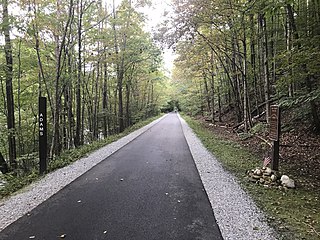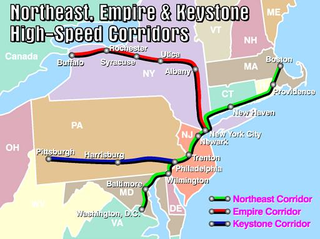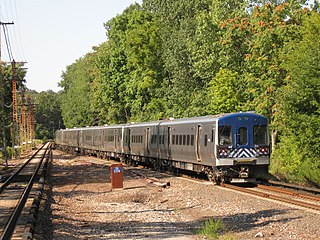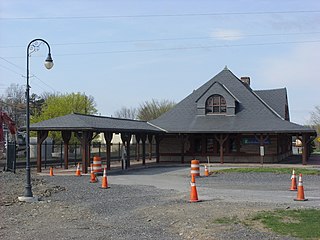
Metro-North Railroad, trading as MTA Metro-North Railroad, is a suburban commuter rail service operated by the Metropolitan Transportation Authority (MTA), a public authority of the U.S. state of New York. Metro-North serves the New York Metropolitan Area, running service between New York City and its northern suburbs in New York and Connecticut, including Port Jervis, Spring Valley, Poughkeepsie, Yonkers, New Rochelle, Mount Vernon, White Plains, Southeast and Wassaic in New York and Stamford, New Canaan, Danbury, Bridgeport, Waterbury, and New Haven in Connecticut. Service in Connecticut is operated under contract with the Connecticut Department of Transportation. Metro-North also provides local rail service within the New York City boroughs of Manhattan and the Bronx.

The New York Central Railroad was a railroad primarily operating in the Great Lakes and Mid-Atlantic regions of the United States. The railroad primarily connected greater New York and Boston in the east with Chicago and St. Louis in the Midwest, along with the intermediate cities of Albany, Buffalo, Cleveland, Cincinnati, Detroit, Rochester and Syracuse. New York Central was headquartered in New York City's New York Central Building, adjacent to its largest station, Grand Central Terminal.

The New York, New Haven and Hartford Railroad, commonly known as The Consolidated, or simply as the New Haven, was a railroad that operated principally in the New England region of the United States from 1872 to December 31, 1968. Founded by the merger of the New York and New Haven and Hartford and New Haven railroads, the company had near-total dominance of railroad traffic in Southern New England for the first half of the 20th century.

Pawling station is a commuter rail stop on the Metro-North Railroad's Harlem Line, located in Pawling, New York.

Brewster station is a commuter rail stop on the Metro-North Railroad's Harlem Line, located in Brewster, New York.

The Ashuwillticook Rail Trail is a 14.2-mile (22.9 km) rail trail built on a former railroad corridor that runs parallel to Route 8 through the towns of Cheshire, Lanesborough and Adams, and into the city of Pittsfield, Massachusetts. It is a multi-use trail for biking, walking, roller-blading, and jogging. The trail is managed by the Massachusetts Department of Conservation and Recreation (DCR).

The Boston and Albany Railroad was a railroad connecting Boston, Massachusetts to Albany, New York, later becoming part of the New York Central Railroad system, Conrail, and CSX Transportation. The mainline is currently used by CSX for freight as the Berkshire Subdivision and Boston Subdivision. Passenger service is provided on the line by Amtrak, as part of their Lake Shore Limited service, and by the MBTA Commuter Rail system, which owns the section east of Worcester and operates it as its Framingham/Worcester Line.

The Empire Corridor is a 461-mile (742 km) passenger rail corridor in New York State running between Penn Station in New York City and Niagara Falls, New York. Major cities on the route include Poughkeepsie, Albany, Schenectady, Amsterdam, Utica, Syracuse, Rochester, and Buffalo. Much of the corridor was once part of the New York Central Railroad's main line.

The Harlem Line is an 82-mile (132 km) commuter rail line owned and operated by the Metro-North Railroad in the U.S. state of New York. It runs north from New York City to Wassaic, in eastern Dutchess County. The lower 53 miles (85 km) from Grand Central Terminal to Southeast, in Putnam County, is electrified with a third rail and has at least two tracks. The section north of Southeast is a non-electrified single-track line served by diesel locomotives. Before the renaming of the line in 1983, it eventually became the Harlem Division of the New York Central Railroad. The diesel trains usually run as a shuttle on the northern end of the line, except for rush-hour express trains in the peak direction.
The New York and Putnam Railroad, nicknamed the Old Put, was a railroad line that operated between the Bronx and Brewster in New York State. It was in close proximity to the Hudson River Railroad and New York and Harlem Railroad. All three came under ownership of the New York Central system in 1894. The railroad was abandoned starting in 1958, and most of the former roadbed has been converted to rail trail use.

The Housatonic Railroad is a Class III railroad operating in southwestern New England and eastern New York. It was chartered in 1983 to operate a short section of ex-New York, New Haven and Hartford Railroad in northwestern Connecticut, and has since expanded north and south, as well as west into New York State.

The Joseph Scelsi Intermodal Transportation Center is a transit facility located in downtown Pittsfield, Massachusetts, United States. The $11 million facility is named after Joseph Scelsi, a longtime State Representative who represented Pittsfield. Owned by the Berkshire Regional Transit Authority (BRTA), it is serviced by local BRTA bus services, Amtrak intercity rail service, and Peter Pan intercity bus service. The second floor of the building houses two classrooms used by Berkshire Community College and Massachusetts College of Liberal Arts.

Adams is a former train station at 10 Pleasant Street in Adams, Massachusetts. Built in 1899, it served as the town's principal rail station on the North Adams Branch of the Boston and Albany Railroad until the mid-20th century. The surviving buildings were listed on the National Register of Historic Places in 1982 as the Pittsfield & North Adams Passenger Station and Baggage & Express House. The former station is currently the home of a sports bar and restaurant.

Union Station is a historic former railroad station located in downtown Palmer, Massachusetts. The building, which was designed by American architect H. H. Richardson, opened in June 1884 to consolidate two separate stations nearby. The grounds of the station were originally designed by Frederick Law Olmsted.

Union Station served the residents of Chatham, New York, from 1887 to 1972 as a passenger station and until 1976 as a freight station. It was the final stop for Harlem Line trains. It had originally served trains of the Boston and Albany Railroad, then the New York Central Railroad and the Rutland Railway. It served as a junction for service that radiated to Rensselaer, New York, to the northwest; Hudson, New York, to the southwest; Vermont, to the northeast, and Pittsfield, Massachusetts to the east and New York City, to the south.

The Millerton station is a former New York Central Railroad (NYC) station on the NYC's Harlem Division that served the residents of Millerton, New York.

The Hudson and Boston Railroad was a railroad that spanned across Southern and Central Columbia County, New York. It was chartered in 1855 and acquired by the Boston and Albany Railroad in 1870, only to face its gradual demise beginning in 1959. Despite its name, it never actually reached Boston, but it did serve as an important connecting line for the Boston and Albany Railroad, which converted it into the B&A Hudson Branch upon acquisition. The line formed a cutoff between the New York Central and Hudson River Railroad towards New York City and the Boston and Albany Railroad, toward Pittsfield, Springfield, Worcester, and Boston.

The Berkshire Flyer is a seasonal Amtrak passenger train service between New York City and the Berkshire Mountains in Pittsfield, Massachusetts, via the Hudson Valley. The weekly train departs Penn Station on Friday and Sunday afternoons during the summer and returns on Sundays. The route's 2023 season began on May 26 and ran through October 9 as the second year of a three-year pilot program.
The Berkshire was a New York, New Haven and Hartford Railroad named train running from New York City's Grand Central Terminal to Pittsfield, Massachusetts. It was the longest-running north–south train in Litchfield Hills of western Connecticut and the Berkshires of Massachusetts. From New York City it followed the New Haven Line to South Norwalk, the Danbury Line to Danbury and the Berkshire Division to Pittsfield. It began in the 1940s and ran until 1968. The train was preceded by the Berkshire Express, of c.1938-c.1943. It terminated at Pittsfield Union Station until 1960, when the New Haven moved it to another station in the city.

East-West Rail is a proposed intercity passenger rail project that would provide new service between Boston and western Massachusetts, with stops including Worcester, Palmer, Springfield, Pittsfield, and Amtrak's Albany–Rensselaer station in New York. The 171-mile (275 km) route between Boston and Albany would use the former mainline of the Boston and Albany Railroad, which is now owned by the Massachusetts Bay Transit Authority and CSX Transportation.



















